Buying an electric van: Your complete guide
While electric vans are still a niche, their popularity is growing as prices come down and ranges increase. But will an electric van work for you? Our guide explains everything you need to know.
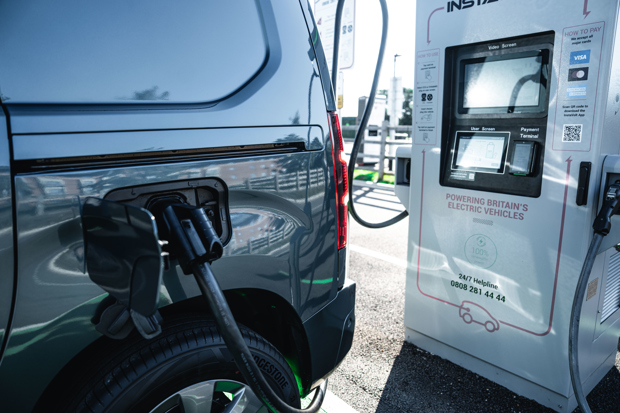
- Will an electric van work for you?
- How electric vans differ from plug-in hybrids
- Are electric vans cheaper to run?
Electric vans: The essential guide
As businesses large and small adapt to a zero emissions future electric vans are growing in popularity. But current technology means battery power alone doesn’t yet suit everyone’s van needs. Diesel remains the default choice for most high-mileage van users, minimising both costs and downtime - at least for now.
Those who have already invested in electric vans are today’s trendsetters but legislation means the landscape will change dramatically over the next decade. From 2030 any new petrol or diesel van sold in the UK will have to be hybrid, while just five years later any brand new light commercial vehicle with a combustion-engine will be banned from sale.
Today’s electric vans make the most sense for those who live or work in urban areas. At lower speeds they work much more efficiently plus there’s a greater density of public chargers if you need to charge during the day.
With all but the biggest electric vans having a real-world range of between 150 and 250 miles (this can vary due to how the van is driven and the ambient temperature) they realistically still only appeal to those covering less than 20,000 miles a year or so. Expect this to change, though, as technology evolves.
Electric vans are exempt from fees for entering the various UK cities operating Clean Air Zones (CAZ) as they do not contribute to air pollution while being driven.
In rural areas public charge points are far less numerous meaning longer distances at higher, less efficient speeds when you’re searching for one.
Public and private investment will continue to improve the situation, with the government announcing a further £55 million cash injection in January 2025.
Whether this improves the public charging network sufficiently or contributes to making it more affordable remains to be seen. At present the infrastructure is probably the single biggest barrier to entry for most potential EV buyers.
How much do electric vans cost?
The price of an electric van is one of the biggest issues facing potential buyers but matters are heading in a positive direction. When the Mercedes-Benz eSprinter first came out in 2019, it cost an eye-watering £100,000 whereas today’s model is 35% cheaper.
The latest Volkswagen Transporter, from the class below, costs around £46,000 and a new Vauxhall Combo is fwill set you back £27,000 – and that’s before the plug-in van grant is deducted. This can shave another £2500 off the list price, so electric vans are rapidly getting cheaper and will soon have price parity with diesel models, if industry analysts are to be believed.
Why are electric vans so expensive?
Historically, electric vans have been very expensive due to the costs of the battery packs and electric motors, but as they become more commonplace, prices are coming down – especially those with Chinese-sourced batteries.
The research and development costs of a new vehicle are factored into the price. So now that many manufacturers have an established EV system, this is getting markedly cheaper.
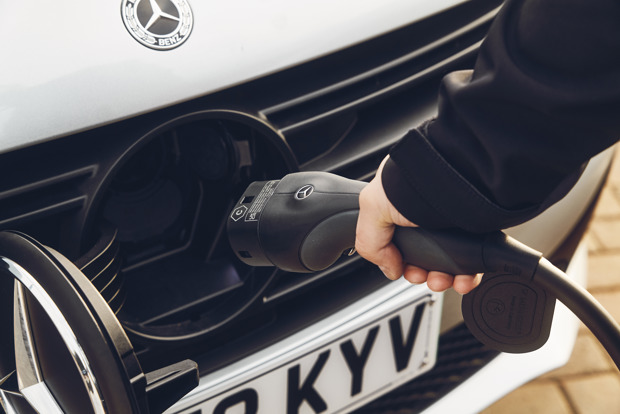
What is the government Plug-in Van Grant (PiVG)?
The Plug-in Van Grant - PiVG for short - is a government-funded incentive that reduces the purchase price of an electric van by up to 35% thanks to a subsidy applied for at the point of purchase.
A total of £120 million has been made available to cover the cost of the PiVG which will continue until at least 2026 even though a similar scheme for electric cars was withdrawn many years ago.
To qualify for the PiVG, a van must be less than 2500kg gross vehicle weight, have CO2 emissions of less than 50g/km and be able to travel at least 60 miles without any emissions
How much does it cost to charge an electric van?
Charging an electric van overnight on a home charger will cost you on average £12 to £16 from a completely flat battery, based on an average home tariff and using a 7kW wall box charger with an average-sized 60Kwh battery. It will be cheaper if you have an EV tariff such as Octopus Intelligent Go.
If you need to fast-charge a similar battery at the roadside, then prices vary depending on the provider. A 10%-80% charge using a fast charger will be closer to £50 and that’s where an electric model will make less sense. However, if you need to charge up on the road, it remains an option.
One of the biggest barriers to people adopting EVs is that the current infrastructure is considered quite expensive to use if you can’t charge at home, but manufacturers and pressure groups are campaigning for this to change.
Home charging
Charging your EV at home is by far the most cost-effective option, but this is often far slower than charging in public. Wallbox chargers offering 7kW charging, will typically cost 11p per kWh (based on 2025 tariffs and including standing charges), resulting in a total cost of around £7 to charge a 50kwH battery.
Standard public chargers
There are typically three different types of public chargers: normal charging (about 28p per kWh), rapid charging (40p per kWh) and ultra-fast charging (50p per kWh). While this is substantially more expensive than charging at home, it’s much faster – super-fast charge a 50kwH battery form 10-80% and it will cost you about £18.
Motorway chargers
These types of chargers offer the same charge rates as public ones, but as with everything at a motorway service station, they are more expensive – expect a 10 to 20% uplift.
What’s the range of an electric van?
Most diesel-engined vans can travel over 500 miles between visits to a filling station but even the longest range electric models of today can only drive 150 to 300 miles before needing to be plugged in.
Ever-improving technology is still extending electric vans’ available driving range, with even greater potential set to be unlocked when solid state batteries become the norm in the near future.
Look how far things have already improved. Using the Mercedes eSprinter as an example, the earliest versions could only go as far as 97 miles before running out of energy, yet a 2025 model can be driven up to 277 miles between charges.
A Ford e-Transit Custom will return 272 miles and a Citroen e-Berlingo around 205 miles based on WLTP combined cycles, but in colder weather or under hard use you may be lucky to see 75% of this figure.
For many users, that mileage will be more than enough for a day’s work, so if you can recharge the van overnight, it’s not a big deal. But there are some users, such as couriers and long-distance distributors for whom a diesel van is still the only option – at least until the next generation of even longer-distance batteries appears.
How are electric vans different to drive from combustion-engined ones?
Generally speaking, an electric van won’t feel too unfamiliar to anyone who is used to driving a diesel van, but with a couple of key differences.
First of all, all electric vans are automatic and usually have just a one-speed transmission. Simply put it in Drive and away you go.
The majority of electric vans come with three or four drive modes – generally an Eco mode to maximise the range, which limits the performance from the electric motor. Then there's usually a Normal and a Performance mode, the latter of which saps battery power in normal use, but can be handy when you need a burst of acceleration, such as joining a motorway from a slip road.
One thing that does take a bit of getting used to is the regenerative braking. This draws out some of the kinetic energy created when slowing down to feed it back into the battery. It can feel like the van is applying its own brakes when slowing down (don’t worry - the brake lights will illuminate at the same time, without you needing to touch the pedal) and in most electric models can be set at different levels.
For example, if you are travelling through town it makes sense to set this at its strongest setting to claw back the most energy you can – on a fast road, you may wish to reduce the regen to allow the van to coast.
Also, electric vans are generally a little bit quicker off the mark than diesel ones, because the torque from the electric motors is instantaneous. They’re a lot quieter, too. They also feel a bit heavier due to the weight of the battery packs, but as these are often mounted under the floor, they tend to also feel more stable, if anything.
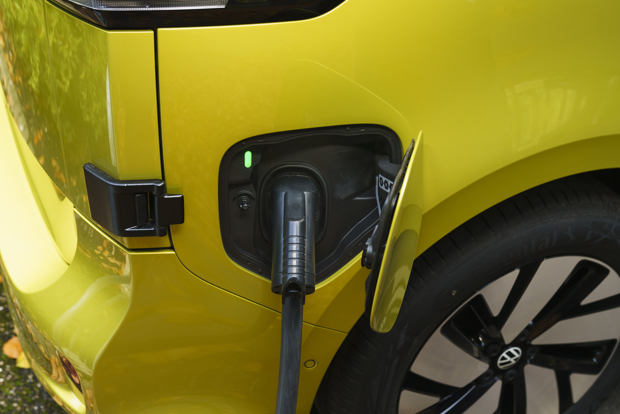
What type of licence do you need to drive an electric van?
To encourage the uptake of zero emission goods vehicles the UK government introduced a 4.25-tonne electric van derogation in 2018 - a legal provision allowing regulatory flexibility.
This means that holders of a standard car driving licence (category B) can drive electric vans weighing up to 4.25 tonnes. This 750kg increase over the usual 3.5-tonne limit - which remains the legal maximum for category B licence holders driving petrol and diesel vans - compensates for the added weight of electric vans’ batteries.
When the scheme was introduced anyone who passed their test after 1 January 1997 was required to undertake an additional five hours’ practical training to qualify for the 4.25t derogation.
This was dropped in 2023 and replaced by an agreement where fleet operators provide their drivers with online training modules. Individuals cannot apply for the 4.25t derogation independently.
There are now proposals under the new Zero Emission Van Plan to drop the need for derogation altogether, recognising that today’s vehicles are generally heavier anyway and weight limits could be affecting electric van take-up rates.
Are there any tax benefits to owning an electric van?
Until 2025 electric vans were exempt from Vehicle Excise Duty (VED) - also known as road tax. This changed for the 2025/26 tax year meaning that from April 2025 onwards electric vans will incur a VED cost of £10 for the first year and £195 per year thereafter.
Fleet operators and small business users are also heavily incentivised to switch to electric vans with reduced-cost tariffs and lower charging point installation fees - you can find out about this here.
There are still benefit-in-kind tax savings as well for buyers who get private mileage out of a company electric van – the BIK element of taxation remains fixed at 0%, for the 2025/25 tax year, at least.
Can I tow with an electric van?
You can but it will have a massively adverse effect on the range due to the weight of the trailer together with whatever is being hauled.
Legal towing weights for electric vans are also usually lower than with equivalent combustion-engined models. The maximum towing capacity of an electric Ford E-Transit Custom is 2300kg compared while a diesel-powered Ford Transit Custom can legally pull along up to 2800kg.
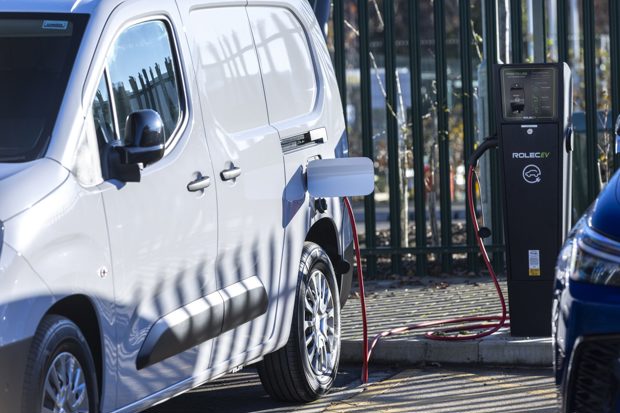
How long do electric vans take to charge?
The time taken to charge an electric van can vary depending on the type of supply, the charger and the size of the battery.
Using the Ford e-Transit Custom as a guide, being the electric version of the UK’s best-selling medium van, using a standard 7kW home charger it takes about 10 hours to take a battery from flat to full.
If you use an 11kW charger, that comes down to about 6hrs 40mins. If you need to charge in a hurry, then a paid-for roadside fast charger will take it from 10% to 80% charge in 37 minutes.
What is EV battery capacity?
When talking about EV battery capacity, or battery size, what we mean is the storage capacity of the battery in kilowatt hours (kWh).
Generally speaking, the larger the kWh, the longer a vehicle’s range. A 100kWh battery, for example, is often good for 300 miles range. A smaller 50kWh one will do maybe half that, but factors such as the vehicles weight and aerodynamics mean such measures are never an exact science.
While bigger batteries add usability, they also generally cost a lot more and will take longer to charge than a smaller battery pack, and are a lot heavier, too. This is why it’s important for manufacturers to find a balance.
What is an on-board charger?
An electric vehicle onboard charger is an essential part of every electric vehicle, as it turns alternating current (AC) from the mains into direct current (DC), to charge the battery. An electric vehicle’s battery can only be charged by DC.
The onboard charger’s main responsibility is converting AC into DC so that you can charge your the battery, and it works by converting that energy when plugged into an AC source, such as at home or certain lower-rated public charging points.
This conversion process doesn’t occur when you plug into a DC charger – these are the rapid or ultra-rapid power points often found at fuel stations or motorway services.
The onboard charger also undertakes other operations, such as monitoring the charging rate of your EV to work out how long it will take for you car to charge up.
Each electric vehicle’s onboard charger has a maximum charging rate – the quickest time in which it can charge with alternating current. For example, if your EV has a maximum charging rate of 7kW, you won’t be able to charge any faster than 7kW, even if you used a 22kW AC charger.
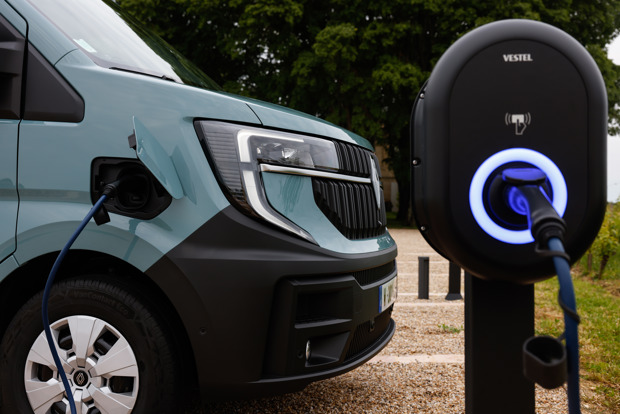
What are the different types of charger?
While you can, in theory, charge an electric van from the mains without a charger, it can take hours and isn’t especially efficient.
Use a home charging unit and an overnight charger while you’re in bed is entirely practical, with most smaller vans taking 8-9 hours to charge or bigger ones taking 10-12 hours. Most household car chargers are 7kW as this is all most people need.
Of course you can also use public chargers. There are three types of public charging point available, too – standard, rapid and ultra-rapid.
A standard charger will normally be rated below 21kW and will take several hours to charge your van, but if you’re leaving it parked up while at a job, for example, it can often be the most affordable option.
A rapid charger, often of the type you’ll find at a supermarket or petrol station, will have an output of 50kW to 149kW. A charging session on one of these will get you from 10-80% in 30-60 minutes, depending on the type of battery that you have and its size.
Ultra rapid chargers are the fastest chargers, rated from 150kW upwards. On some luxury cars, they’re capable of a 10-80% charge of the most advanced battery packs in 10-15 minutes. This is likely to passed on to LCVs as battery technology develops.
How long do electric van batteries last?
While all batteries will deteriorate over time, all EV manufacturers so far have guaranteed their batteries for eight years and 100,000 miles. And there are many EVs in service that have covered much greater mileages already.
Generally speaking, battery life so far does not seem to be an issue for EV users.
Are batteries leased separately?
When EVs were in their infancy, some manufacturers, notably Renault, leased batteries instead of selling them. This is no longer the case and all electric vans come with batteries that are owned outright by the vehicle’s owner.
Does it make sense to buy a used electric van?
Early electric vans aren’t as efficient or as technologically advanced as today’s models but can make sense for used LCV buyers who typically cover low daily mileages in urban areas.
Both the Nissan e-NV200 and early Citroen e-Berlingo are good examples of electric vans that are now very cheap to buy thanks to a limited used audience - there are bargains to be had.
More recent electric vans make more sense used than new in many cases. First-year depreciation on them has generally been very steep meaning there are some great deals about.
Do consider that the pace of development in the EV market means that today’s electric vans might look outdated in a few years’ time, which will take further toll on their residual values.
What are the differences between an electric van and a plug-in hybrid?
A plug-in hybrid offers electric power alongside a normal petrol or diesel engine. The electric batteries are much smaller than pure EVs and offer a range of 20-30 miles as a rule, after which the ICE engine takes over.
They’re handy for people who travel short distances in urban areas but may require a need to go further occasionally. The Ford e-Transit Custom was the first PHEV van in the UK, but there are more Ford and Volkswagen models to follow.
What are the differences between an electric van and a range extender?
A range extender – such as the London taxi-based LEVC VN5 – differs from a PHEV in that while the principle is the same, as in you run on electricity only until the battery goes flat, the onboard ICE engine only ever works as a generator to sustain the charge of the battery. The petrol engine never directly drives the wheels.
Which manufacturers sell electric vans?
The majority of van manufacturers have electric models in their line-ups but some offer the technology across a broader range of van sizes than others. Electrification makes it easier for car manufacturers to enter the vans market for the first time as well as paving the way for new and unfamiliar brands to sell their wares in the UK.
How many electric vans are there in the UK?
According to EV charging network analysts, ZapMap, at the beginning of 2025, there were just over 76,000 electric vans registered in the UK – a number that is rising every month.
